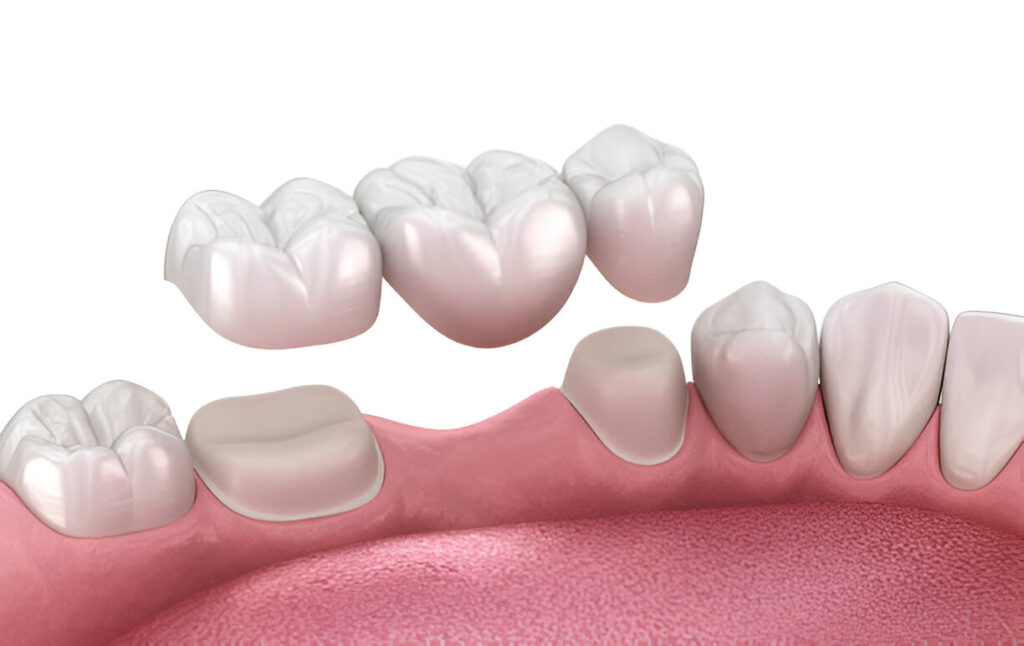Many people ask if they can get a filling instead of a crown. It’s a fair question. Fillings are cheaper, quicker, and feel less scary to some patients. But the answer depends on the condition of your tooth. Fillings and crowns both fix damaged teeth, but they’re not the same. A filling is used for smaller problems. A Crowns & Bridges is needed when the tooth is weak or broken. In this article, we’ll explain what each treatment does, when each one is needed, and how to choose the right one. Let’s help you decide what’s best for your smile.
What Is the Difference Between a Filling and a Crown?
A filling repairs a tooth that has a small hole caused by decay. The dentist removes the bad part of the tooth and fills the space with a strong material. This could be a white filling (composite), silver (amalgam), or even gold. A crown, on the other hand, is a cover that goes over the whole tooth. It is used when the tooth is badly damaged or has had a root canal. Crowns are made of porcelain, metal, or a mix of both. Fillings are quicker to place, but crowns are stronger and last longer in many cases.
Does a Crown Require a Root Canal?
When Is a Filling the Right Choice?
A permanent filling is a great option when the damage is small. If the cavity is not too deep, and the tooth still has most of its natural structure, a filling will likely work well. Fillings are placed in just one visit and don’t need a lot of the tooth to be removed. They can be done quickly and are more affordable than crowns. If your tooth isn’t cracked, hasn’t had lots of past fillings, and isn’t weakened by decay, your dentist might suggest a filling. It’s a simple fix that keeps the tooth healthy and strong.
When Is a Crown a Better Option?
Sometimes, a filling just isn’t strong enough. If your tooth is badly damaged, a crown is the better choice. This is common when a tooth has had a large cavity, multiple fillings, or root canal treatment. A crown protects what’s left of the tooth. It stops it from breaking and keeps your bite strong. If a tooth is cracked, weak, or mostly filling already, it might not last long with another filling. A crown covers the tooth completely, giving it new shape and strength. It also helps stop pain and keeps your smile looking and feeling natural.
How Long Do Fillings and Crowns Last?
Both fillings and crowns can last for many years, but it depends on the material used and how you care for your teeth. White fillings (composite) last about 5 to 10 years. Silver and gold fillings may last longer. Crowns usually last 10 to 15 years, sometimes even longer with good care. Crowns are stronger and better for teeth that take more pressure from chewing. If you take care of your mouth—brush, floss, and visit your dentist—you can help your dental work last longer. Ask your dentist how long your specific treatment is expected to last.
Is There a Big Difference in Cost and Time?
Yes, there is. Fillings are faster and cheaper than crowns. A filling usually takes about 30 to 60 minutes and is finished in one visit. Crowns take two visits. The first visit is for shaping the tooth and taking an impression. The second visit is to fit the crown. In between, you’ll wear a temporary crown. Fillings cost less than crowns because they’re simpler and don’t require a lab to make anything. Crowns cost more due to materials and time. But remember—choosing the right one depends on your tooth’s condition, not just the price.
Can You Get a Filling When You Really Need a Crown?
Sometimes patients want a filling even if a dentist recommends a crown. But using a filling when a crown is truly needed can lead to problems. The filling may fall out, or the tooth might break. This could cause pain, infection, or even tooth loss. If the dentist says a crown is best, they usually have a good reason. Still, it’s okay to ask why. Your dentist should explain it clearly. Working together, you can decide what’s best for your tooth and your budget. Don’t be afraid to ask questions during your dental visit.
What is the Difference Between a Cap and a Crown?
Looking After Your Tooth After Treatment
Whether you get a filling or a crown, taking care of your tooth is very important. Brush your teeth twice a day using a soft toothbrush. Floss once a day to clean between your teeth. Avoid very hard, crunchy, or sticky foods—these can damage fillings or crowns. Don’t chew ice or use your teeth to open things. See your dentist every six months for a check-up. They will make sure your filling or crown is still in good shape. Good habits at home and regular visits can keep your smile healthy for many years to come.
Visit YAH Polyclinic for Expert Dental Advice
Not sure whether you need a filling or a crown? At YAH Polyclinic, our caring dental team will assess your tooth and guide you toward the right treatment. We provide honest advice, gentle care, and tailored solutions to protect your smile. Book your consultation today and take the first step toward stronger, healthier teeth.
Frequently Asked Questions
Can a permanent filling last as long as a crown?
Permanent fillings can last 5 to 10 years, while crowns often last 10 to 15 years or more. Crowns are stronger and protect weak teeth better. Fillings work well for smaller repairs, but crowns are usually chosen for long-term strength when a tooth is badly damaged.
Is a crown always necessary after a root canal?
Yes, in most cases. After a root canal, the tooth becomes hollow and weaker. A crown protects it from breaking and keeps it strong for chewing. Without a crown, the tooth might crack or fail over time, especially if it’s a back tooth that handles more pressure.
What happens if I delay getting a crown?
Delaying a crown when it’s needed can lead to serious issues. The tooth may break, hurt, or become infected. If the damage gets worse, you might need more treatment or even lose the tooth. It’s best to follow your dentist’s advice to avoid bigger problems later.
Can a tooth with many fillings still be saved?
Yes, but it may need a crown. A tooth with multiple fillings has lost much of its natural strength. A crown can hold the tooth together, protect it from breaking, and help it last longer. It gives full coverage and is better than adding another filling on top.
Are white fillings strong enough for back teeth?
White (composite) fillings are strong and look natural. They can be used on back teeth, especially for small to medium cavities. However, if the filling is very large or the tooth is under a lot of pressure, your dentist may recommend a crown for better protection and durability.





